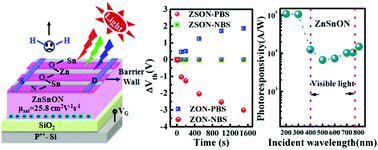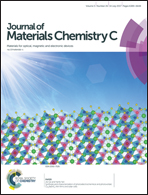Combined control of the cation and anion to make ZnSnON thin films for visible-light phototransistors with high responsivity†
Abstract
A novel oxynitride semiconductor, ZnSnON, is demonstrated. The design of this material follows the reported anion control strategy (N additives) to diminish the bandgap and the electron effective mass of ZnO on the one hand, and a cation control strategy (Sn additives) to circumvent the chemical stability problems of ZnON on the other. Comparative studies are conducted on the performance and stability of ZnSnON and ZnON films and their thin-film transistors (TFTs). It is shown that ZnSnON possesses superior transport properties and enhanced operation stability simultaneously. Such amelioration is owing to multiple factors, including the amorphous/nanocrystalline mixed phase and the bonding strength increase caused by the Sn-related oxide/oxynitride dominant in the back channel region. In addition, the Sn additives in ZnON do not alter the direct bandgap character, maintaining around 1.6 eV. The ZnSnON-TFT is photosensitive in the whole visible light region with a photoresponsivity higher than 6 × 103 A W−1. Considering the high-mobility, improved operation stability, and visible light sensing capability, this semiconductor can be used in a broad array of applications such as in active-matrix imaging arrays, interactive displays, flat X-ray detectors, etc.



 Please wait while we load your content...
Please wait while we load your content...